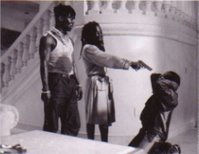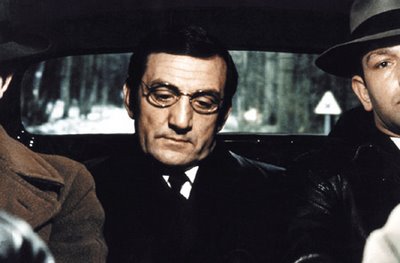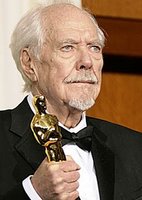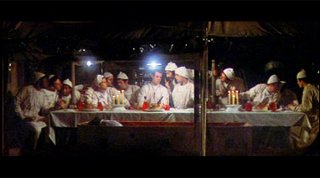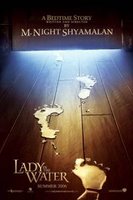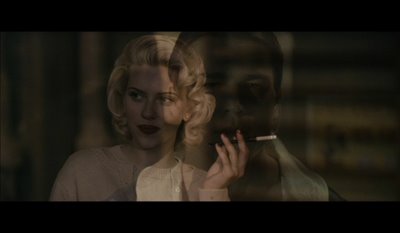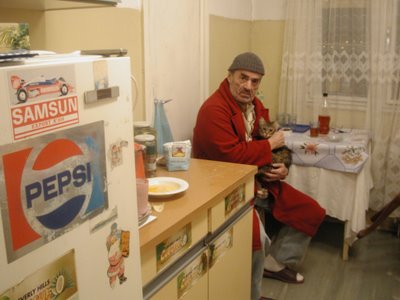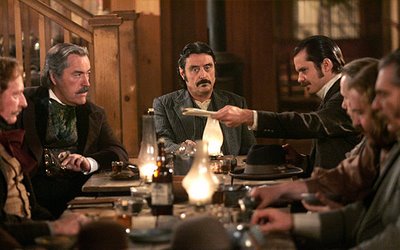
The year in television 2006 was most marked by just how easy it was to watch TV at your own chosen time, rather than a time chosen for you by network heads. DVRs made it easy to postpone watching your favorite show a few hours or even a few weeks. If you had to wait months, you could always turn to the inevitable DVD set and buzz through an entire season in a long weekend. And if you missed something completely, you could always turn to watching it on a network Web site or, less legally, on YouTube or via BitTorrent.
 While many publications have realized that these events were significant in some fashion (Time magazine, no less, named all of humanity person of the year for seizing the reins of the information age so dramatically), few have realized just how significant they could be, given the right time and proper room to grow. Sure YouTube made mincemeat of public figures as varied as George Allen and Michael Richards, but it could prove an even bigger revolution when it comes to distribution models. Television, which has never had a proper independent television movement, seems poised to leave behind a network as a necessity, just as thousands of bands now more easily communicate with fans through their Web sites and offer MP3s through same.
While many publications have realized that these events were significant in some fashion (Time magazine, no less, named all of humanity person of the year for seizing the reins of the information age so dramatically), few have realized just how significant they could be, given the right time and proper room to grow. Sure YouTube made mincemeat of public figures as varied as George Allen and Michael Richards, but it could prove an even bigger revolution when it comes to distribution models. Television, which has never had a proper independent television movement, seems poised to leave behind a network as a necessity, just as thousands of bands now more easily communicate with fans through their Web sites and offer MP3s through same.
Because networks have always controlled what got on the air, an independent movement has never had room to flourish in television. In the world of film, if you had a camera, some film stock and a few free weekends, you and your friends could throw together a movie, even if would almost certainly be awful. Perhaps you could cajole the local theater owner into showing it or submit it to film festivals where a variety of independent distributors might consider send it out to theaters nationwide or, at the very least, throwing it on DVD. It has never been so with television. Theoretically, it would be just as easy to shoot a TV series independently as it would be to shoot a film, but once it was completed, who would show your finished series? The networks, controlling the means of distribution, prefer to keep a tight lid on what gets shown, right down to the script stage. Although there are independent television festivals in their infancy, they haven’t resulted in anything that has made it to the air.
 But all of that changes if you don’t need to make it to the air to be seen. If you can shoot a series on your own, then throw up a trailer on YouTube and put the episodes up on BitTorrent (or some easier-to-use equivalent) one by one, you don’t need to ever be on a network -- sure, the reach of the networks far exceeds that of even the most visited Web sites, but get your series in the hands of the right blogs and you might even start a bit of buzz. And from there, it’s not hard to imagine old media networks springing up to air the best stuff they find on the Net or at independent TV festivals -- sort of a Miramax or Picturehouse on the broadcast dial.
But all of that changes if you don’t need to make it to the air to be seen. If you can shoot a series on your own, then throw up a trailer on YouTube and put the episodes up on BitTorrent (or some easier-to-use equivalent) one by one, you don’t need to ever be on a network -- sure, the reach of the networks far exceeds that of even the most visited Web sites, but get your series in the hands of the right blogs and you might even start a bit of buzz. And from there, it’s not hard to imagine old media networks springing up to air the best stuff they find on the Net or at independent TV festivals -- sort of a Miramax or Picturehouse on the broadcast dial.
We’ve seen the nascent beginnings of this on YouTube and other sites. What were the Strong Bad shorts that were so popular a few years ago if not Adult Swim cartoons condensed to their smallest possible lengths? And what was the lonelygirl15 saga if not a fairly typical teen soap reimagined as a series of Webcast missives? While, admittedly, none of this comes close to rivaling the best of television proper, the quality of it has grown substantially in just the last few years, and it only continues to get better. Is there any doubt that 15 years from now, the number of shows the serious student of television will have to watch will include one or two that are exclusive to the Internet?
 All of this may prove to be idle speculation, but even if only a small fraction of it comes true, it could prove to turn the television industry into a Titanic, taking on water just as rapidly as the flailing record industry. What is needed, perhaps more than ever, are good critics, willing to sort through the increasing number of broadcast options as well as the rapidly multiplying number of options online. If 95% of everything is awful (and the Internet vastly increases the number of “something”), then there’s going to be that much more of a need to direct viewers to the stuff that truly shines. Fortunately, the Internet has helped with that too.
All of this may prove to be idle speculation, but even if only a small fraction of it comes true, it could prove to turn the television industry into a Titanic, taking on water just as rapidly as the flailing record industry. What is needed, perhaps more than ever, are good critics, willing to sort through the increasing number of broadcast options as well as the rapidly multiplying number of options online. If 95% of everything is awful (and the Internet vastly increases the number of “something”), then there’s going to be that much more of a need to direct viewers to the stuff that truly shines. Fortunately, the Internet has helped with that too.
2006 was also the year that the television blog finally came into its own. The Internet is perhaps the ideal medium to deal with the constantly shifting landscape of television. While it can take a few days to get a story about a significant episode of primetime television into a newspaper or magazine, all it takes is a few minutes to put that same post up on a blog. Not all of this commentary is as insightful as it could be, but by posting instant reactions to primetime TV, television blogs created a forum where TV fans could discuss their favorite shows and speculate about them. Some of the best television blogs are run by professional critics. Some are run by people within the industry. And some are run by amateurs who just want to share their love of the medium. By harnessing what’s unique about both the Internet and television (namely, their “never sleep” nature), television blogs have become one of the best places to critically dissect the medium.
None of this is to say that the television medium suffered a lackluster year in 2006. Far from it, in fact. It was a strong year for some of the best returning shows, and it boasted a strong crop of new shows too. In order, the 10 best television programs of 2006 were:
 1. The Wire and When the Levees Broke: A Requiem in Four Acts (both HBO): HBO offered two very different takes on the death of the American city this year, one calmly studious but full of a quiet rage, the other upfront in its anger, willing to bleat its rage from rooftops. The Wire, David Simon’s careful examination of the failure of institutions in the city of Baltimore, returned after two years off the air with its finest season yet, restructuring itself to be about a group of inner city kids struggling to survive. As with any season of The Wire, the dense plotting returned rewards in spade, and the politics, such as they were, struck a stronger blow against the bureaucracy inherent in any political institution than any number of carefully considered OpEd columns could. And the series even works as detective thriller for those wishing to avoid its political implications. Simon and his writers craft their narrative in the tradition of social novelists of the early 20th century like Upton Sinclair and Sinclair Lewis, and the payoff this season was as well-wrought as it was heartbreaking.
1. The Wire and When the Levees Broke: A Requiem in Four Acts (both HBO): HBO offered two very different takes on the death of the American city this year, one calmly studious but full of a quiet rage, the other upfront in its anger, willing to bleat its rage from rooftops. The Wire, David Simon’s careful examination of the failure of institutions in the city of Baltimore, returned after two years off the air with its finest season yet, restructuring itself to be about a group of inner city kids struggling to survive. As with any season of The Wire, the dense plotting returned rewards in spade, and the politics, such as they were, struck a stronger blow against the bureaucracy inherent in any political institution than any number of carefully considered OpEd columns could. And the series even works as detective thriller for those wishing to avoid its political implications. Simon and his writers craft their narrative in the tradition of social novelists of the early 20th century like Upton Sinclair and Sinclair Lewis, and the payoff this season was as well-wrought as it was heartbreaking.
 Spike Lee’s When the Levees Broke, however, was far more willing to use a loudspeaker to broadcast its message. Originally broadcast on the anniversary of Hurricane Katrina, Levees was one of the first documents to capture the whole picture of what happened inside New Orleans during that awful week in 2005. While the sections where various politicians try to pass the blame on to each other can be tiring, they also deliver the sense that no one wanted to own up to messing up the initial reaction to the tragedy that was unfolding. Lee is unafraid of painting that tragedy in as bleak a light as possible. He uses jazz and other music to create several haunting montages -- one of dead bodies floating through the streets -- and he has a fine skill as an interviewer at prying the story of what happened from his subjects. Lee’s Inside Man was an entertaining enough heist movie, but this documentary was his true triumph in 2006, and an example of how the medium can do the long-form documentary right.
Spike Lee’s When the Levees Broke, however, was far more willing to use a loudspeaker to broadcast its message. Originally broadcast on the anniversary of Hurricane Katrina, Levees was one of the first documents to capture the whole picture of what happened inside New Orleans during that awful week in 2005. While the sections where various politicians try to pass the blame on to each other can be tiring, they also deliver the sense that no one wanted to own up to messing up the initial reaction to the tragedy that was unfolding. Lee is unafraid of painting that tragedy in as bleak a light as possible. He uses jazz and other music to create several haunting montages -- one of dead bodies floating through the streets -- and he has a fine skill as an interviewer at prying the story of what happened from his subjects. Lee’s Inside Man was an entertaining enough heist movie, but this documentary was his true triumph in 2006, and an example of how the medium can do the long-form documentary right.
 2. Battlestar Galactica (SciFi): Strange, perhaps, that the most relevant document about the current conflicts the United States finds itself embroiled in would be a television science fiction series, of all things, but Galactica is a wrenching, raw account of soldiers living on the edge, daring to fight back against an Other they barely know. Filled with strong, quiet acting from the likes of Edward James Olmos and Mary McDonnell, the series took big risks this year, settling its main characters on a planet, then having the enemy occupy that planet and expanding the show’s borders beyond its conventional “apocalypse in space” set-up.
2. Battlestar Galactica (SciFi): Strange, perhaps, that the most relevant document about the current conflicts the United States finds itself embroiled in would be a television science fiction series, of all things, but Galactica is a wrenching, raw account of soldiers living on the edge, daring to fight back against an Other they barely know. Filled with strong, quiet acting from the likes of Edward James Olmos and Mary McDonnell, the series took big risks this year, settling its main characters on a planet, then having the enemy occupy that planet and expanding the show’s borders beyond its conventional “apocalypse in space” set-up.
3. Deadwood (HBO): The worst season of this series is still better than most seasons of other shows. While the scenes between Ian McShane’s Al Swearengen and Gerald McRaney’s George Hearst were the pure, ugly poetry the series does so very well and the plotline about Hearst’s dream of buying out the entire town was compelling, there were a lot of loose ends and meandering plotlines that just made one wish the fourth season creator David Milch had wanted had gone ahead so the audience could see what, exactly, was his final vision for the series. Still, there were so many stellar episodes and moments in the season that placing it any lower would feel unfair to one of the medium’s finest achievements.
 4. The Office (NBC): Funnier than it has any right to be, the U.S. series found its own rhythms in 2006, finally breaking free of its British forebear. Grounded in strong, character-based writing and one of the deepest ensembles in sitcom history, the series balanced a hilarious dissection of American workplace drudgery with moments of true heart, then suggested that the only way the series could play fair with the audience was to go on to break all of its characters’ hearts. Amazingly, this deeply unconventional series has found a devoted cult audience that should ensure many seasons to come.
4. The Office (NBC): Funnier than it has any right to be, the U.S. series found its own rhythms in 2006, finally breaking free of its British forebear. Grounded in strong, character-based writing and one of the deepest ensembles in sitcom history, the series balanced a hilarious dissection of American workplace drudgery with moments of true heart, then suggested that the only way the series could play fair with the audience was to go on to break all of its characters’ hearts. Amazingly, this deeply unconventional series has found a devoted cult audience that should ensure many seasons to come.
 5. Friday Night Lights (NBC): Oddly poetic for a show about football, Friday Night Lights has become the low-rated critical cause celebre of the season, largely because it has too much football for the small-town show fans and not enough football for the sports fans. None of that should be any matter to the curious viewer, though, who will find a show about kids trying to escape their dead-end town, using any means necessary (anything from sex to football). H.G. Bissinger’s book works better as a TV show than it did as a movie (and I really liked the movie) because it can delve into the inner workings of the town it portrays, giving all of its many characters a fair shake.
5. Friday Night Lights (NBC): Oddly poetic for a show about football, Friday Night Lights has become the low-rated critical cause celebre of the season, largely because it has too much football for the small-town show fans and not enough football for the sports fans. None of that should be any matter to the curious viewer, though, who will find a show about kids trying to escape their dead-end town, using any means necessary (anything from sex to football). H.G. Bissinger’s book works better as a TV show than it did as a movie (and I really liked the movie) because it can delve into the inner workings of the town it portrays, giving all of its many characters a fair shake.
 6. Big Love (HBO): A re-viewing on DVD convinced me that this series, warmly reviewed enough when it first aired but not greeted with the sort of rapturous acclaims that other HBO series are met with, was better than it first appeared to be. In many ways, it’s the series Six Feet Under always aspired to be -- a series that uses the tropes of the sensationalistic family soap to get at deeper things in the American psyche. Unlike Six Feet, though, Big Love’s central premise is so ridiculous that it never needs to resort to the grand theatrics of the earlier series. It’s a frank examination of religion, morality, sexual politics and the American dream, filtered through a universe where our standard ideas of family don’t apply. It’s even a really sneaky argument for legalizing gay marriage.
6. Big Love (HBO): A re-viewing on DVD convinced me that this series, warmly reviewed enough when it first aired but not greeted with the sort of rapturous acclaims that other HBO series are met with, was better than it first appeared to be. In many ways, it’s the series Six Feet Under always aspired to be -- a series that uses the tropes of the sensationalistic family soap to get at deeper things in the American psyche. Unlike Six Feet, though, Big Love’s central premise is so ridiculous that it never needs to resort to the grand theatrics of the earlier series. It’s a frank examination of religion, morality, sexual politics and the American dream, filtered through a universe where our standard ideas of family don’t apply. It’s even a really sneaky argument for legalizing gay marriage.
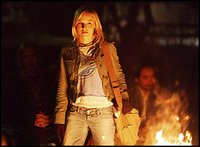 7. Veronica Mars (The CW): The first nine episodes of season three made some missteps, but the last half of season two was the finest the show has been, mixing the weekly mysteries with the over-arching mystery and the soap opera plotlines. In its own way, Mars also tackles the U.S. class system. While not as searing an indictment as The Wire, its portrayal of a world where some of the characters have no hope simply because of the economic lifestyle they’re born into rings truer than we would like it to. And even Season Three, once it had ditched some of its sillier machinations, concluded its first arc on a high note.
7. Veronica Mars (The CW): The first nine episodes of season three made some missteps, but the last half of season two was the finest the show has been, mixing the weekly mysteries with the over-arching mystery and the soap opera plotlines. In its own way, Mars also tackles the U.S. class system. While not as searing an indictment as The Wire, its portrayal of a world where some of the characters have no hope simply because of the economic lifestyle they’re born into rings truer than we would like it to. And even Season Three, once it had ditched some of its sillier machinations, concluded its first arc on a high note.
 8. The Colbert Report (Comedy Central): While The Daily Show with Jon Stewart remains lively and essential (even if its newest correspondents are fairly snooze-inducing), The Colbert Report has come into its own this year. Stephen Colbert’s persona has grown more merciless even as it gains the praise of the Bill O’Reillys it sets out to mock. Colbert is maybe the deftest improv comedian on television right now, and his ability to come up with exactly the right one-liner at exactly the right moment all the while remaining in character is well-night awe-inspiring. The show gets bonus points for the bizarrely funny guitar battle with The Decemberists, which even let Henry Kissinger in on the fun.
8. The Colbert Report (Comedy Central): While The Daily Show with Jon Stewart remains lively and essential (even if its newest correspondents are fairly snooze-inducing), The Colbert Report has come into its own this year. Stephen Colbert’s persona has grown more merciless even as it gains the praise of the Bill O’Reillys it sets out to mock. Colbert is maybe the deftest improv comedian on television right now, and his ability to come up with exactly the right one-liner at exactly the right moment all the while remaining in character is well-night awe-inspiring. The show gets bonus points for the bizarrely funny guitar battle with The Decemberists, which even let Henry Kissinger in on the fun.
9. How I Met Your Mother (CBS): While the sitcom has made a comeback during the past year, you wouldn’t know it from glancing at the ratings, where only the mediocre Two-and-a-Half Men sits anywhere near the top. This series, which is easily on the worst possible network it could be on, has attracted a deeply devoted cult simply by having a winning ensemble and tight writing that calls to mind classics like Cheers. It’s nothing deeply innovative, and, really, there are “greater” series on television, but it does what it does well, and that’s nothing to denigrate.
 10. 24 and Lost (Fox and ABC): Complain away. The former is a nearly fascist action movie that makes little to no sense and leaves behind so many plot holes it’s a wonder Jack Bauer doesn’t fall in to any of them. The latter is an oft-stupid series that thinks too much of itself and relies on Byzantine plotting and self-conscious weirdness, as well as a flashback structure that underlines every bit of subtext for the audience. But when these series are on, even if it’s just for one scene per episode, there’s nothing more entertaining or enthralling on the air. Much of series television is about dragging the audience into the moment, and no series do that better than 24 and Lost. If The Wire and When the Levees Broke are sublime, then 24 and Lost are the necessary ridiculous counterparts, but they are, at least, thrillingly ridiculous.
10. 24 and Lost (Fox and ABC): Complain away. The former is a nearly fascist action movie that makes little to no sense and leaves behind so many plot holes it’s a wonder Jack Bauer doesn’t fall in to any of them. The latter is an oft-stupid series that thinks too much of itself and relies on Byzantine plotting and self-conscious weirdness, as well as a flashback structure that underlines every bit of subtext for the audience. But when these series are on, even if it’s just for one scene per episode, there’s nothing more entertaining or enthralling on the air. Much of series television is about dragging the audience into the moment, and no series do that better than 24 and Lost. If The Wire and When the Levees Broke are sublime, then 24 and Lost are the necessary ridiculous counterparts, but they are, at least, thrillingly ridiculous.
No top ten list is an exact science. The first five have been set in stone for a while now, but there was something like a 30-way tie for sixth place. To that end, here are 15 runners-up I would have been happy swapping in for any of these programs without being too worried.
In alphabetical order:
 30 Rock (NBC): Tina Fey’s series has a great Alec Baldwin performance at its center and a wild willingness to try new things.
30 Rock (NBC): Tina Fey’s series has a great Alec Baldwin performance at its center and a wild willingness to try new things.
Bleak House (PBS): Fine acting and a strong script made this one of the finest Dickens adaptations ever committed to film.
The Boondocks (Cartoon Network): Aaron McGruder’s creation is a closely observed African-American mash-up of Desperate Housewives and King of the Hill.
Brotherhood (Showtime): A little slow-moving but ultimately rewarding, Brotherhood was unfortunately underseen, despite a warm critical reception.
Dexter (Showtime): A little too blithe in how it treats its hero and full of barely-sketched in supporting characters, this is still genuinely thrilling TV and a nifty twist of the procedural structure.
Doctor Who (SciFi): Deeply uneven but winningly acted and capable of episodes of great power, this is the finest remake since Battlestar Galactica.
 Everybody Hates Chris (The CW): Few series on television make regular conflict out of making ends meet, but Chris makes it both moving and funny.
Everybody Hates Chris (The CW): Few series on television make regular conflict out of making ends meet, but Chris makes it both moving and funny.
House (Fox): The formula is starting to impair the good doctor, but the medical mysteries are still fascinating, and Hugh Laurie is still delivering one of TV’s best performances.
Life on Mars (BBC America): The edits from the UK to US versions made some of the action inscrutable, but this time-traveling cop series had cool to spare.
My Name Is Earl (NBC): The central premise grows ever-more unwieldy, but the supporting players on the show are so fantastic that it’s easy to not care.
 One Punk Under God (Sundance): Jay Bakker, son of Jim and Tammy Faye, is a fascinating subject for this documentary about Christianity in America.
One Punk Under God (Sundance): Jay Bakker, son of Jim and Tammy Faye, is a fascinating subject for this documentary about Christianity in America.
Project Runway (Bravo): I don’t know a thing about fashion, but this reality series is so well-cast that that hardly even matters.
Scrubs (NBC): Finally giving up on being a ratings success, the series just decided to appease its rabid cult, and was the funniest it’s been in years.
The Sopranos (HBO): The sixth season started out so strong that its last half was bound to disappoint. Still, the sense of reckoning hanging over the show gives high hopes for the upcoming final episodes.
Ugly Betty (ABC): A cutesy pilot and an irritating adherence to the chick lit genre obscure this series’ true strengths: an examination of class and a willingness to let all of its stereotypes have layers.
Gone too soon: Lots of series were canceled this year, but I’ll miss most of all Fox’s deeply ambitious comedy Arrested Development, ABC’s even more ambitious comedy Sons and Daughters, The WB’s dreamy family drama Everwood and ABC’s creepily effective sci-fi thriller Invasion.
Other stuff: Here are some things I enjoy -- even without enjoying them as a whole:
 The comedy of Rescue Me: The drama is often too over-the-top or demeaning to women, but the comedy scenes in this firefighter series are always worth it.
The comedy of Rescue Me: The drama is often too over-the-top or demeaning to women, but the comedy scenes in this firefighter series are always worth it.
The last five minutes of Heroes: Ponderous and uneven (though that makes it easy to fast forward through certain characters’ storylines), the series comes to life in its last few minutes with its perfect cliffhangers.
The workplace scenes in The Loop: Philip Baker Hall and Mimi Rogers are so hilarious as the boss and sexual predator in this series that the second season will feature much more of them.
The music in Grey’s Anatomy: The series itself is slowly devouring itself, but the musical choices have gotten more adventurous in the third season, ranging from TV on the Radio to the Dixie Chicks.
Stuff I didn’t get to: No one critic can watch everything, but I’m particularly ashamed to have missed The Shield, Weeds, most PBS regular series (Frontline in particular) and Broken Trail. I’ll do better in 2007. Promise.
 The worst: It’s almost too easy, but there’s nothing more nauseating on television than Nancy Grace, Headline News’ shrieking harridan of injustice, whose perfect goal would be a judicial system where the only judge, jury and executioner was Nancy herself. Her low point? Interviewing a woman whose son had disappeared, all but indicting that woman for the crime, then going ahead with plans to air that interview after the woman killed herself. The cable news networks are mostly wastelands, but Grace is a nadir among nadirs.
The worst: It’s almost too easy, but there’s nothing more nauseating on television than Nancy Grace, Headline News’ shrieking harridan of injustice, whose perfect goal would be a judicial system where the only judge, jury and executioner was Nancy herself. Her low point? Interviewing a woman whose son had disappeared, all but indicting that woman for the crime, then going ahead with plans to air that interview after the woman killed herself. The cable news networks are mostly wastelands, but Grace is a nadir among nadirs.
__________________________________________________
House Next Door contributor Todd VanDerWerff is the publisher of the pop culture blog South Dakota Dark.
TO READ THE FULL POST WITH COMMENTS, CLICK HERE
 By Matt Zoller Seitz
By Matt Zoller Seitz I revisited the article at about 5 AM on December 31, quite involuntarily, after realizing that the introductory paragraph I'd been working on for the past half-hour sounded weirdly like something I'd heard or read someplace before; terrified of rehashing movie dialogue or someone else's criticism without meaning to, I did a Google search on keywords, and realized I was circling back around to images and phrases I'd toyed with in print two-and-a-half years earlier. It was deja vu all over again. Writing is a hall of mirrors, a combination journal and photo album that exists in your head from cradle to grave, present tense; so I guess it's inevitable that no matter what I write about, it somehow circles around to something I've seen before or written about before, someplace I've been before, someone I knew before.
I revisited the article at about 5 AM on December 31, quite involuntarily, after realizing that the introductory paragraph I'd been working on for the past half-hour sounded weirdly like something I'd heard or read someplace before; terrified of rehashing movie dialogue or someone else's criticism without meaning to, I did a Google search on keywords, and realized I was circling back around to images and phrases I'd toyed with in print two-and-a-half years earlier. It was deja vu all over again. Writing is a hall of mirrors, a combination journal and photo album that exists in your head from cradle to grave, present tense; so I guess it's inevitable that no matter what I write about, it somehow circles around to something I've seen before or written about before, someplace I've been before, someone I knew before.  When I peruse the archives -- collected in the sidebar on the main site, and grouped by month -- I'm struck by how often certain subjects recur, from Terrence Malick, Michael Mann and Steven Spielberg to Looney Tunes and Disney to Deadwood, The Wire and the Sci-Fi Channel to persistent arguments over politics, sex and violence in popular culture. Some of these were my obsessions -- in fact, the impetuts to start the site was to beat the drum for The New World, a masterpiece that had inexplicably met mostly with indifference, condescension or hostility in its home country. But other people brought their own fascinations, and over time, those fascinations jump-started mine -- and in a couple of cases, took me places I might not otherwise have gone. The list would have to include N.P. Thompson's interview with screenwriter Stewart Stern, which prompted me to revisit much of what Stern wrote; Odienator's ongoing interests in Douglas Sirk and Wilder's Wares; Wagstaff's appreciation of the original Bad News Bears, which caused me to revisit not just that movie, but much of director Michael Ritchie's work; Odienator and Keith Uhlich's diametrically opposed views on Miami Vice, which got me thinking about the aesthetics of television vs. movie drama, digital video and commercial storytelling conventions, in order to better justify my interest in Mann, and Steven Boone's review of Iraq in Fragments, which made me want to pick up a camera and start making movies again. Peruse the sidebar for more.
When I peruse the archives -- collected in the sidebar on the main site, and grouped by month -- I'm struck by how often certain subjects recur, from Terrence Malick, Michael Mann and Steven Spielberg to Looney Tunes and Disney to Deadwood, The Wire and the Sci-Fi Channel to persistent arguments over politics, sex and violence in popular culture. Some of these were my obsessions -- in fact, the impetuts to start the site was to beat the drum for The New World, a masterpiece that had inexplicably met mostly with indifference, condescension or hostility in its home country. But other people brought their own fascinations, and over time, those fascinations jump-started mine -- and in a couple of cases, took me places I might not otherwise have gone. The list would have to include N.P. Thompson's interview with screenwriter Stewart Stern, which prompted me to revisit much of what Stern wrote; Odienator's ongoing interests in Douglas Sirk and Wilder's Wares; Wagstaff's appreciation of the original Bad News Bears, which caused me to revisit not just that movie, but much of director Michael Ritchie's work; Odienator and Keith Uhlich's diametrically opposed views on Miami Vice, which got me thinking about the aesthetics of television vs. movie drama, digital video and commercial storytelling conventions, in order to better justify my interest in Mann, and Steven Boone's review of Iraq in Fragments, which made me want to pick up a camera and start making movies again. Peruse the sidebar for more. 

